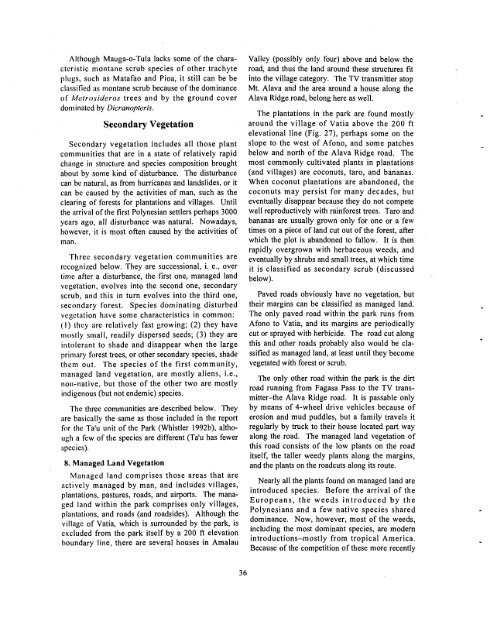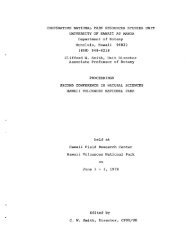american samoa - University of Hawaii at Manoa
american samoa - University of Hawaii at Manoa
american samoa - University of Hawaii at Manoa
You also want an ePaper? Increase the reach of your titles
YUMPU automatically turns print PDFs into web optimized ePapers that Google loves.
Although Mauga-o-Tula lacks some <strong>of</strong> the chara-<br />
cteristic montane scrub species <strong>of</strong> other trachyte<br />
plugs, such as M<strong>at</strong>afao and Pioa, it still can be be<br />
classified as montane scrub because <strong>of</strong> the dominance<br />
<strong>of</strong> Metrosideros trees and by the ground cover<br />
domin<strong>at</strong>ed by Dicranopleris.<br />
Secondary Veget<strong>at</strong>ion<br />
Secondary veget<strong>at</strong>ion includes all those plant<br />
communities th<strong>at</strong> are in a st<strong>at</strong>e <strong>of</strong> rel<strong>at</strong>ively rapid<br />
change in structure and species composition brought<br />
about by some kind <strong>of</strong> disturbance. The disturbance<br />
can be n<strong>at</strong>ural, as from hurricanes and landslides, or it<br />
can be caused by the activities <strong>of</strong> man, such as the<br />
clearing <strong>of</strong> forests for plant<strong>at</strong>ions and villages. Until<br />
the arrival <strong>of</strong> the first Polynesian settlers perhaps 3000<br />
years ago, all disturbance was n<strong>at</strong>ural. Nowadays,<br />
however, it is most <strong>of</strong>ten caused by the activities <strong>of</strong><br />
man.<br />
Three secondary veget<strong>at</strong>ion communities are<br />
recognized below. They are successional, i. e., over<br />
time after a disturbance, the first one, managed land<br />
veget<strong>at</strong>ion, evolves into the second one, secondary<br />
scrub, and this in turn evolves into the third one,<br />
secondary forest. Species domin<strong>at</strong>ing disturbed<br />
veget<strong>at</strong>ion have some characteristics in common:<br />
(I) they are rel<strong>at</strong>ively fast growing; (2) they have<br />
mostly small, readily dispersed seeds; (3) they are<br />
intolerant to shade and disappear when the large<br />
primary forest trees, or other secondary species, shade<br />
them out. The species <strong>of</strong> the first community,<br />
managed land veget<strong>at</strong>ion, are mostly aliens, i.e.,<br />
non-n<strong>at</strong>ive, but those <strong>of</strong> the other two are mostly<br />
indigenous (but not endemic) species.<br />
The three communities are described below. They<br />
are basically the same as those included in the report<br />
for the Ta'u unit <strong>of</strong> the Park (Whistler 1992b), altho-<br />
ugh a few <strong>of</strong> the species are different (Ta'u has fewer<br />
species).<br />
8. Managed Land Veget<strong>at</strong>ion<br />
Managed land comprises those areas th<strong>at</strong> are<br />
actively managed by man, and includes villages,<br />
plant<strong>at</strong>ions, pastures, roads, and airports. The managed<br />
land within the park comprises only villages,<br />
plant<strong>at</strong>ions, and roads (and roadsides). Although the<br />
village <strong>of</strong> V<strong>at</strong>ia, which is surrounded by the park, is<br />
excluded from the park itself by a 200 ft elev<strong>at</strong>ion<br />
boundary line, there are several houses in Amalau<br />
Valley (possibly only four) above and below the<br />
road, and thus the land around these structures fit<br />
into the village c<strong>at</strong>egory. The TV transmitter <strong>at</strong>op<br />
Mt. Alava and the area around a house along the<br />
Alava Ridge road, belong here as well.<br />
The plant<strong>at</strong>ions in the park are found mostly<br />
around the village <strong>of</strong> V<strong>at</strong>ia above the 200 ft<br />
elev<strong>at</strong>ional line (Fig. 27), perhaps some on the<br />
slope to the west <strong>of</strong> Afono, and some p<strong>at</strong>ches<br />
below and north <strong>of</strong> the Alava Ridge road. The<br />
most commonly cultiv<strong>at</strong>ed plants in plant<strong>at</strong>ions<br />
(and villages) are coconuts, taro, and bananas.<br />
When coconut plant<strong>at</strong>ions are abandoned, the<br />
coconuts may persist for many decades, but<br />
eventually disappear because they do not compete<br />
well reproductively with rainforest trees. Taro and<br />
bananas are usually grown only for one or a few<br />
times on a piece <strong>of</strong> land cut out <strong>of</strong> the forest, after<br />
which the plot is abandoned to fallow. It is then<br />
rapidly overgrown with herbaceous weeds, and<br />
eventually by shrubs and small trees, <strong>at</strong> which time<br />
it is classified as secondary scrub (discussed<br />
below).<br />
Paved roads obviously have no veget<strong>at</strong>ion, but<br />
their margins can be classified as managed land.<br />
The only paved road within the park runs from<br />
Afono to V<strong>at</strong>ia, and its margins are periodically<br />
cut or sprayed with herbicide. The road cut along<br />
this and other roads probably also would be cla-<br />
ssified as managed land, <strong>at</strong> least until they become<br />
veget<strong>at</strong>ed with forest or scrub.<br />
The only other road within the park is the dirt<br />
road running from Fagasa Pass to the TV trans-<br />
mitter-the Alava Ridge road. It is passable only<br />
by means <strong>of</strong> 4-wheel drive vehicles because <strong>of</strong><br />
erosion and mud puddles, but a family travels it<br />
regularly by truck to their house loc<strong>at</strong>ed part way<br />
along the road. The managed land veget<strong>at</strong>ion <strong>of</strong><br />
this road consists <strong>of</strong> the low plants on the road<br />
itself, the taller weedy plants along the margins,<br />
and the plants on the roadcuts along its route.<br />
Nearly all the plants found on managed land are<br />
introduced species. Before the arrival <strong>of</strong> the<br />
Europeans, the weeds introduced by the<br />
Polynesians and a few n<strong>at</strong>ive species shared<br />
dominance. Now, however, most <strong>of</strong> the weeds,<br />
including the most dominant species, are modern<br />
introductions-mostly from tropical America.<br />
Because <strong>of</strong> the competition <strong>of</strong> these more recently
















